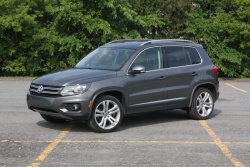 2012 Volkswagen Tiguan Highline. Click image to enlarge |
|
Test Drive: 2012 Volkswagen Tiguan Highline
Manufacturer’s web site |
Review and photos by Chris Chase
Photo Gallery:
2012 Volkswagen Tiguan
Sometimes, made-up words work as car names; other times they don’t. When Volkswagen let the German public name its first compact crossover utility vehicle (CUV) and they chose Tiguan (a hybrid of the German words for tiger and iguana), well, that was one of those ‘other’ times. Surely there must have been another North African tribe (Touareg) or wind (Passat, Jetta, Scirocco) they could have named it for.
For better or worse, Tiguan it was in 2009, and it continues to be for the vehicle VW pits against some of the biggest-selling names in Canada, such as CR-V, RAV4 and Escape. As is the Volkswagen way, this car is positioned as a slightly upscale alternative to the household names in the category.
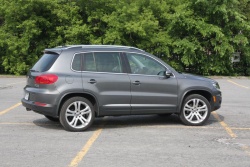 2012 Volkswagen Tiguan Highline. Click image to enlarge |
The most obvious change for 2012 is in the Tiguan’s appearance, which gets an edgy update to bring it in line with the rest of the VW range. The only part I’m not keen on is the amphibious-vehicle look of the front bumper, which looks especially ungainly with my tester’s optional 19-inch wheels.
The tailgate is new, too, so why not take the opportunity to integrate the release handle into the VW badge, a la Golf? Instead, they left the only means of opening the tailgate down at the bottom of the door, where it will spend all winter and every rainy day being one of the dirtiest parts of the car.
Inside, 2012 brings new air conditioning controls and steering wheel. Thankfully, the cool round dash vents were left alone.
Volkswagen’s 2.0L turbocharged, four-cylinder FSI engine is carried over with its power ratings of 200 horsepower and 207 lb-ft of torque intact. A six-speed automatic transmission (standard in all but the base front-drive model) is carried over from 2011, but with some revisions to reduce fuel consumption. Fifth and sixth gears are now both overdrive ratios, and the electronics have been reprogrammed for earlier upshifts.
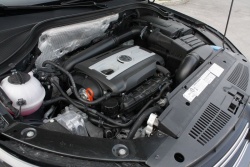 2012 Volkswagen Tiguan Highline. Click image to enlarge |
The updates make a big dent in Natural Resources Canada’s ratings for the Tiguan, which for 2012 drop to 9.8/7.4 L/100 km (city/highway) with automatic and all-wheel drive, from 11.6/8.3 for a comparable 2011 model. My tester averaged 10.2 L/100 km in city driving, falling closer in line with the U.S. Environmental Protection Agency’s more realistic figures, which work out to 11.2/8.7 L/100 km city/highway.
Good news for fuel economy fans, but this re-imagined transmission occasionally gets confused, upshifting so eagerly that it will often downshift again, mid-stream, to get the car up to cruising speeds in a realistic amount of time (a period generally defined by the impatient drivers looking at the Tiguan’s taillights). The ironic thing is that this engine, with its generous low-end torque that peaks at just 1,700 rpm, can move the Tiguan reasonably well at low revs, so the early upshifting isn’t the problem; the transmission’s indecisiveness is.
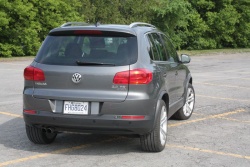 2012 Volkswagen Tiguan Highline. Click image to enlarge |
But the gearbox’s easily confused nature is fairly common nowadays, with fuel economy being at the top of so many minds. Also common is how well the Tiguan’s drivetrain responds to a good flogging. Volkswagen’s 2.0L FSI four-cylinder turbocharged motor is as solid a performer as ever here, and the transmission gets its head on straight the heavier the driver’s right foot gets, helpfully holding onto a lower gear if it thinks you’re in the mood for speed.
That goes well with the Tiguan’s typical German driving dynamics. This little crossover moves more like a car than just about any of the other car-based vehicles it competes with. The steering is light at low speeds but returns good road feel at higher speeds, and especially when the car is tossed into a corner. The firm brake pedal is a good thing most of the time, except when you need a lot of stopping right now, and it becomes so firm it feels like it’s telling you “it’s not a good time, please come back later.” My tester had the optional Sport package, a $1,900 addition that includes 19-inch wheels and tires (too big, though the wide tires look good from the rear) and a sport-tuned suspension (too stiff). The only things worthwhile here are the adaptive (steerable) xenon headlights, but those alone aren’t worth the punishing ride and the cost of replacing 19-inch tires every three years.
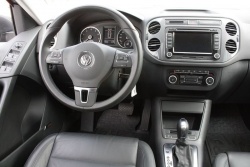 2012 Volkswagen Tiguan Highline. Click image to enlarge |
Weird brake feel aside, the Tiguan is an uncharacteristically entertaining small CUV, and so I wonder if its dialled-in chassis would be lost on the majority of shoppers in this class. Many people are buying into a marketing message in this segment (you need an SUV, and oh my, but you won’t survive another winter without all-wheel drive!) and would be just as well served by the small and medium station wagons that were (mostly) shown the door when the people making the car company money decisions realized how profitable SUVs could be. (I realize many people do benefit from a CUV’s added ground clearance and all-wheel drive, but there are just as many, if not more, who think they need it more than they really do.)
Back to my original point: the Tiguan is one of the best-driving CUVs you can get, but does that matter to anyone other than VW loyalists? Ford sold eight Escapes last year for every Tiguan VW moved, and the Dodge Journey’s sales numbers were almost six times larger; and then there’s the CR-V, RAV4, Santa Fe, Tucson, and so on.
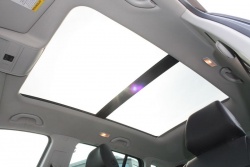 2012 Volkswagen Tiguan Highline. Click image to enlarge |
Volkswagen’s take on the small CUV doesn’t create the roomiest interior in the class, but it’s certainly roomy enough. The panoramic sunroof—standard on the mid-range Comfortline model and in my tester’s Highline trim—steals some headroom, but there was enough to begin with that it’s not much of a problem. Rear seat legroom is the dimension that most defies expectations based on the car’s tidy overall size. The backrest adjusts for angle, and some seating space can be sacrificed for cargo room with the fore-and-aft adjustment. The Tiguan benefits from VW’s usual upscale interior treatment, with plenty of soft-touch material on the dash and leather that feels a little richer than what this car’s Asian competition uses.
The Tiguan’s starting price is $27,875, a price that gets you front-wheel drive and a manual transmission. That right there is part of VW’s problem: the big sellers it competes against all come with automatics out of the box, and that’s what the majority of crossover buyers want. The 2012 Honda CR-V is priced at $25,990 to start, with FWD and automatic transmission, and the most basic Toyota RAV is even cheaper, at $24,865.
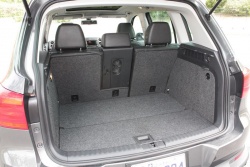 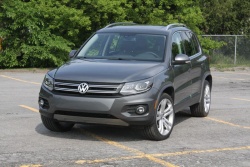 2012 Volkswagen Tiguan Highline. Click image to enlarge |
My Tiguan tester was a top-trim Highline model, which comes standard with the six-speed automatic, VW’s 4MOTION all-wheel drive and a starting MSRP of $38,375. On top of that, VW threw in the Technology (300-watt stereo, navigation, rear parking sensors, and backup camera, $2,300) and Sport (19-inch wheels and tires, steerable bi-xenon headlights, flared wheel arches, and sport suspension, $1,900) packages, which drove the as-tested price to $42,575 (not including freight).
Honda and Toyota typically come to mind when thinking about vehicles with money-grab price tags, so it’s worth noting that the most expensive CR-V (Touring) is worth $35,090, while the priciest RAV4 (4WD V6 Limited) is a $37,300 vehicle. Both of those include navigation, heated leather seats, all-wheel drive and automatic transmissions. The top-spec versions of the Honda and Toyota both include a sunroof, but not the fantastic panoramic type that practically turns the Tiguan into a convertible when opened.
Even if you take away this Tiguan’s options, the Highline is still a $38,375 vehicle, which no longer includes navigation, backup camera and parking sensors, while both the top-end Honda and Toyota lack parking sensors but keep most of the other luxury goodies, including heated seats (which are standard in the Honda starting with the $28,090 LX 4WD model).
Going upscale is the Volkswagen way, but its Jetta sedan has enjoyed considerable sales success since a redesign in 2011 that created a new base model with a lower price, but at the expense of the interior quality VW is known for. I’ve got to wonder if a similar fate awaits the Tiguan, a vehicle that could be a big seller if it weren’t so much pricier than its competition. With a full redesign of this car probably two years away, I’ll have to wait to see if my hunch—that VW is willing to trade some of its uppity brand image for more sales—is on the money.
|
Pricing: 2012 Volkswagen Tiguan Highline
Specifications
Competitors
Crash test results
|











